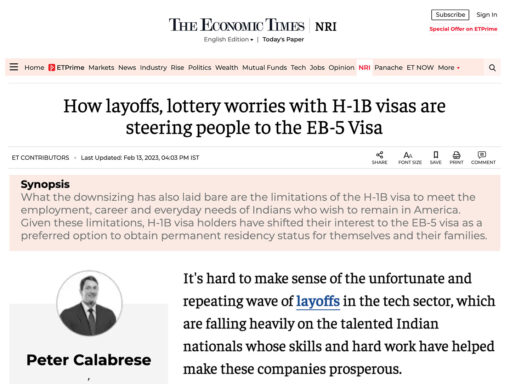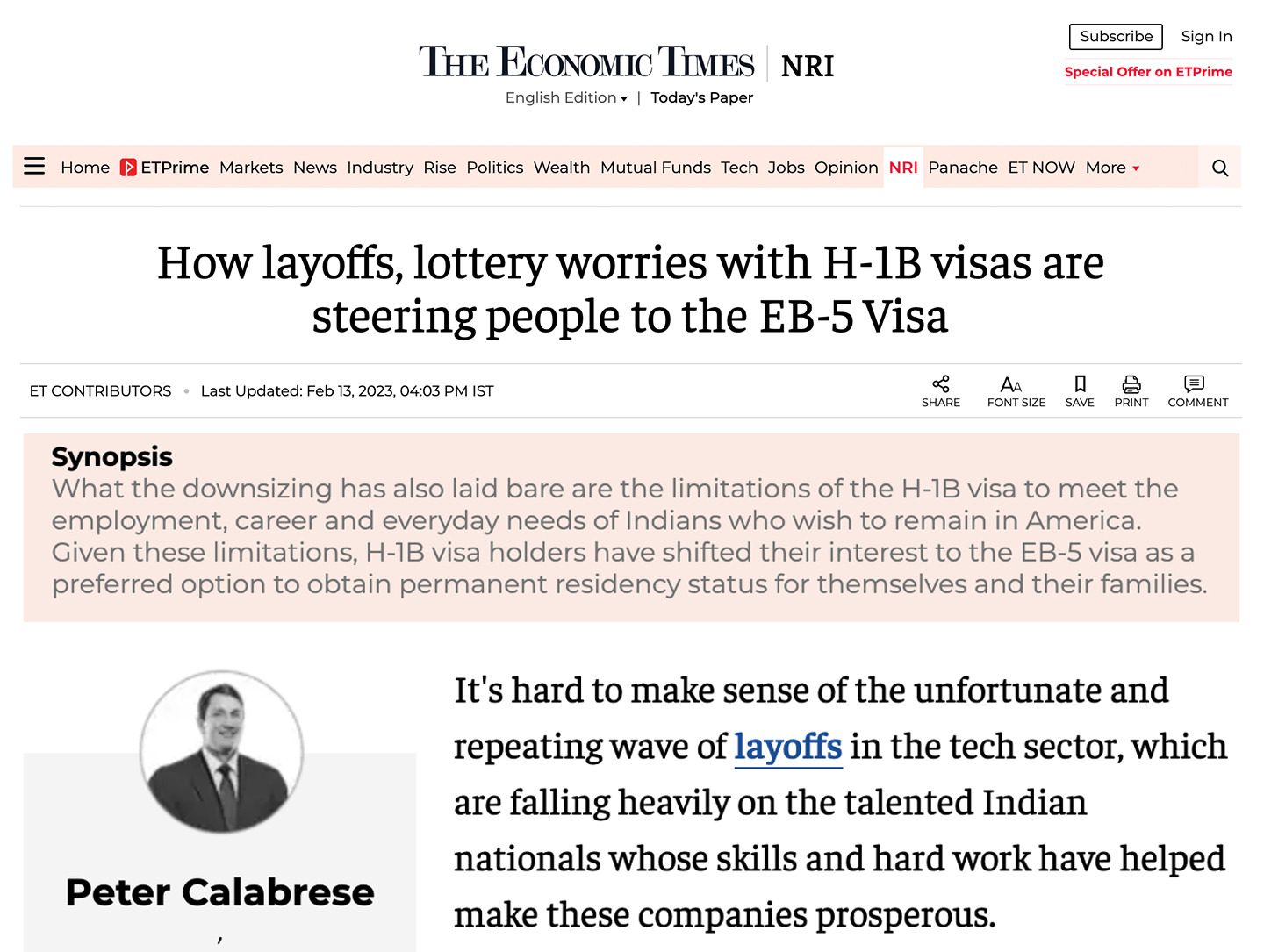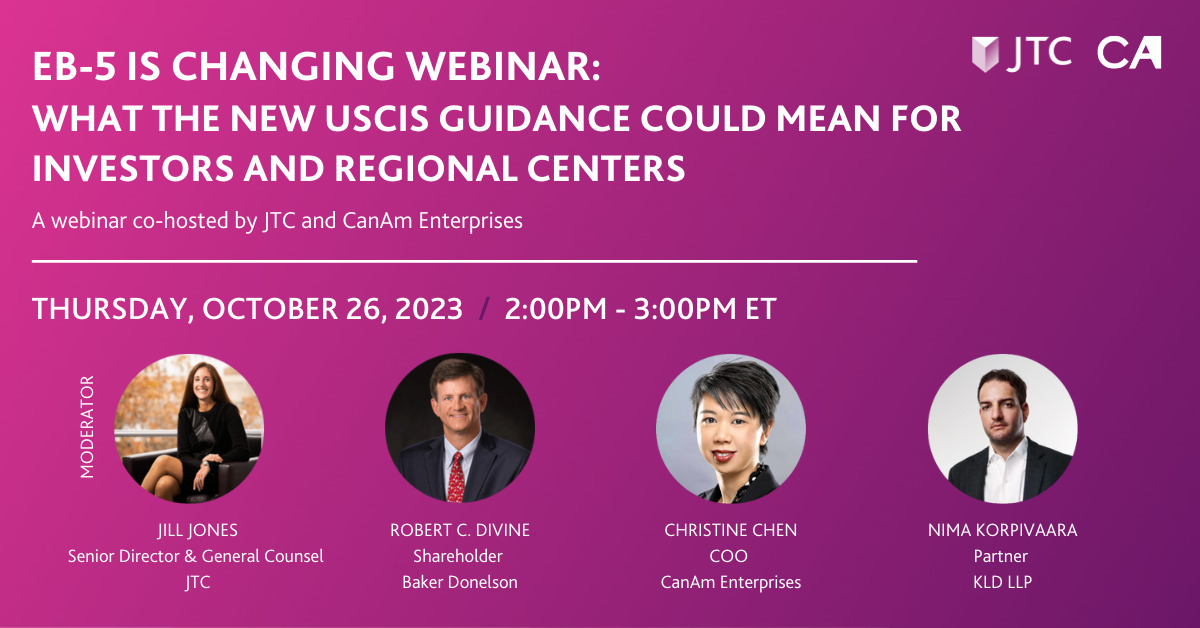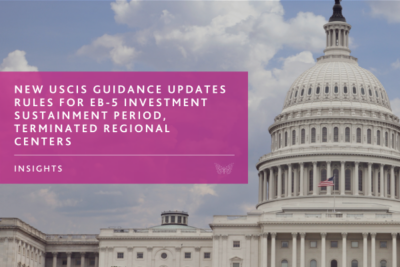By Peter Calabrese

It’s hard to make sense of the unfortunate and repeating wave of layoffs in the tech sector, which are falling heavily on the talented Indian nationals whose skills and hard work have helped make these very companies successful and prosperous. More than 216,000 tech employees have been laid off since the start of 2022, according to Layoffs. fyi, a site that tracks job cuts in the sector. What the downsizing has also laid bare are the limitations of the H-1B visa to meet the employment, career and everyday needs of Indians who wish to remain in America. Given these limitations, H-1B visa holders have shifted their interest to the EB-5 visa as a preferred option to obtain permanent residency status for themselves and their families. Newly enacted immigration laws make this option easier to act upon. The EB-5 Reform and Integrity Act (RIA) makes it possible to concurrently file the EB-5 Petition and Adjustment of Status so H-1B holders can change their visa status while still in the United States.
EB-5 as an alternative has also been encouraged by U.S. Citizenship and Immigration Services (USCIS) through a December, 19, 2022 alert as tech layoff announcements began mounting.
H-1B and EB-5 – The differences
The H-1B visa has unquestionably opened doors of economic opportunity. More than 2 million have been distributed since 2001 but the program was also capped in 2005 and is now is subject to backlogs. By design, this visa is also temporary.
- Stays in the U.S. are no longer than six years.
- The visas are also contingent upon employer sponsorship and upon employment.
- The visa is revoked 60 days after employment is terminated.
- H-1B visa access is subject to backlogs and a lottery.
At its core, the H-1B is not a vehicle for immigration. So, should Indians decide to pursue new career opportunities in the U.S., live and travel there without restriction and have their children live and study in America, the H-1B would fall far short of providing the visa status required to deliver on those aspirations.
Like the H-1B visa, EB-5 provides immigrants with lawful status to live and work in the United States. But unlike with H-1B visas, EB-5 immigration-by-investment visa holders enjoy the following benefits:
- Have no visa sponsorship requirements.
- Eligible to receive monetary return on their investment.
- Can live and work anywhere in the U.S., including states with no state income tax.
- Children (single and under the age of 21) have lower-cost education and employment opportunities.
- Have a clear pathway to permanent U.S. residency.
EB-5 — The Fast Facts
- 10,000 EB-5 visas per year allocated for immigrants and their dependent family members.
- Immigrant investors can directly invest in their own business that creates at least 10 full-time jobs for U.S. workers or through a USCIS-designated Regional Center that pools EB-5 investments into qualifying, job-creating projects.
- Priority visa processing available when a Regional Center’s qualifying project is in a certain category, such as a rural region.
- Investors are eligible to receive principal repayment following the maturity of the loan (usually within 4-7 years).
- Qualified foreign investors receive a temporary, two-year green card in return for investment amounts as low as $800,000 (in projects located in high unemployment areas).
There are three important things to know about the minimum investment associated with the EB-5 visa program:
- These funds are an investment – not a fee, charge, tax or other out of pocket cost that is forfeited. Capital is returned to the investor following the completion of the qualifying EB-5 project.
- These investments can take many forms, such as a gift, real estate, or a loan secured by property, to name a few. An immigration attorney can assist you with identifying these and other options.
- You may add security and confidence in your investment by considering an EB-5 Regional Center that is also a broker/dealer.
Despite their unique nature, EB-5 Investments are treated the same as stocks, bonds, or more traditional financial instruments. The new integrity rules of the RIA mirror many of the rigorous regulatory requirements of FINRA (Financial Industry Regulatory Authority) and the SEC (Securities and Exchange Commission) designed to combat and weed out bad actors in the industry. As the CEO of CanAm Enterprise’s broker dealer, I welcome these protections. The new rules also now provide for a policy already in practice at CanAm: retaining a third-party fund administrator to track EB-5 capital transactions in real time. This practice provides an added layer of transparency, confidence, and security for investors.
A tech layoff event – or even the possibility of one — can be a life-changing one, but it can also be life-changing for all the right reasons. It may open the door to a more secure and permanent new life in the U.S. for you and your family. If CanAm Enterprises can help answer any questions you may have, please contact us today. https://www.canamenterprises.com/contact-us/
Peter Calabrese is CEO at CanAm Investor Services, a FINRA-registered broker dealer affiliated with CanAm Enterprises, one of the leading EB-5 regional center operators.
CanAm Enterprises, with over three decades of experience promoting immigration-linked investments in the US and Canada, has a demonstrated track record of success. With over 60 financed projects and $3 billion in raised EB-5 investments, CanAm has earned a reputation for credibility and trust. To date, CanAm has repaid more than $2.26 billion in EB-5 capital from over 4,530 families. CanAm manages several USCIS-designated regional centers that stretch across multiple states. For more information, please visit www.canamenterprises.com.







